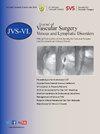Ablation length, not modality type, determines healing outcomes in venous leg ulcers
IF 2.8
2区 医学
Q2 PERIPHERAL VASCULAR DISEASE
Journal of vascular surgery. Venous and lymphatic disorders
Pub Date : 2025-08-29
DOI:10.1016/j.jvsv.2025.102308
引用次数: 0
Abstract
Objective
Early endovenous intervention of the saphenous system improves healing and recurrence of venous leg ulcers (Clinical-Etiology-Anatomy-Pathophysiology class 6). As ablative methods continue to evolve, it is essential to identify outcome differences between the various techniques. This study aims to compare wound healing rates between primary nonthermal ablation (cyanoacrylate glue [CAG] or commercial polidocanol microfoam ablation [MFA]) and thermal ablation with adjunct MFA.
Methods
In this multicenter retrospective cohort study, patients with healed venous ulcers after nonthermal endovenous treatment were identified from four tertiary referral US institutions. Demographics, comorbidities, procedural, and wound data were collected. Patients whose full-length great saphenous vein was treated with a single nonthermal modality (CAG or MFA) were compared with those treated with radiofrequency ablation plus MFA of the below-knee segment. Multivariate linear regression was performed to identify predictors of wound healing.
Results
We identified 55 patients (27 primary CAG or MFA and 28 radiofrequency ablation plus MFA). The average age was 70 ± 12 years, 56% were male, and 53% had a body mass index of >30 kg/m2. Comorbidities were similar between the cohorts. The median ulcer size was 3 cm2. The median time to wound healing was 61 days (interquartile range, 30-258 days) with no significant difference between treatment modalities (P = .37), irrespective of ulcer size category. The rate of ulcer recurrence was 16% and did not differ between the cohorts (P = .46). Multivariate linear regression identified proximal access site as the only independent predictor of prolonged wound healing (P = .03).
Conclusions
Treatment of the full-length great saphenous vein with a single nonthermal modality (CAG or MFA) or a thermal modality plus MFA below the knee have comparable times to wound healing. This finding suggests that comprehensive treatment, irrespective of modality, of the entire great saphenous vein to the ankle is the preferred approach for optimal wound healing in Clinical-Etiology-Anatomy-Pathophysiology class 6 patients.
消融术长度,而非方式类型,决定下肢静脉性溃疡的愈合结果。
目的:隐静脉系统早期静脉内介入治疗可改善下肢静脉性溃疡的愈合和复发(CEAP-6)。随着烧蚀方法的不断发展,确定各种技术之间的结果差异是至关重要的。本研究旨在比较初级非热[氰基丙烯酸酯胶(CAG)或商业聚多元醇微泡沫消融(MFA)]和热辅助MFA的伤口愈合率。方法:在这项多中心回顾性队列研究中,来自美国四家三级转诊机构的经非热静脉内治疗后静脉溃疡愈合的患者。收集了人口统计学、合并症、手术和伤口数据。将全长大隐静脉(GSV)采用单一非热方式(CAG或MFA)治疗的患者与采用膝下段RFA + MFA治疗的患者进行比较。采用多元线性回归来确定伤口愈合的预测因素。结果:55例确诊患者(27例原发性CAG或MFA, 28例RFA+MFA)。平均年龄70±12岁,男性占56%,体重指数bb0 ~ 30kg/m2占53%。两组患者的合并症相似。溃疡中位数为3cm2。伤口愈合的中位时间为61天(IQR 30-258),治疗方式之间无显著差异(p=0.37),与溃疡大小类别无关(图1)。溃疡复发率为16%,两组间无差异(p=0.46)。多元线性回归发现近端通路是伤口愈合时间延长的唯一独立预测因子(p=0.03)。结论:采用单一非热方式(CAG或MFA)或膝关节以下热加MFA治疗全长GSV的伤口愈合时间相当。这表明,对于CEAP-6患者而言,无论采用何种方式,对踝关节的整个GSV进行综合治疗是最佳伤口愈合的首选方法。
本文章由计算机程序翻译,如有差异,请以英文原文为准。
求助全文
约1分钟内获得全文
求助全文
来源期刊

Journal of vascular surgery. Venous and lymphatic disorders
SURGERYPERIPHERAL VASCULAR DISEASE&n-PERIPHERAL VASCULAR DISEASE
CiteScore
6.30
自引率
18.80%
发文量
328
审稿时长
71 days
期刊介绍:
Journal of Vascular Surgery: Venous and Lymphatic Disorders is one of a series of specialist journals launched by the Journal of Vascular Surgery. It aims to be the premier international Journal of medical, endovascular and surgical management of venous and lymphatic disorders. It publishes high quality clinical, research, case reports, techniques, and practice manuscripts related to all aspects of venous and lymphatic disorders, including malformations and wound care, with an emphasis on the practicing clinician. The journal seeks to provide novel and timely information to vascular surgeons, interventionalists, phlebologists, wound care specialists, and allied health professionals who treat patients presenting with vascular and lymphatic disorders. As the official publication of The Society for Vascular Surgery and the American Venous Forum, the Journal will publish, after peer review, selected papers presented at the annual meeting of these organizations and affiliated vascular societies, as well as original articles from members and non-members.
 求助内容:
求助内容: 应助结果提醒方式:
应助结果提醒方式:


